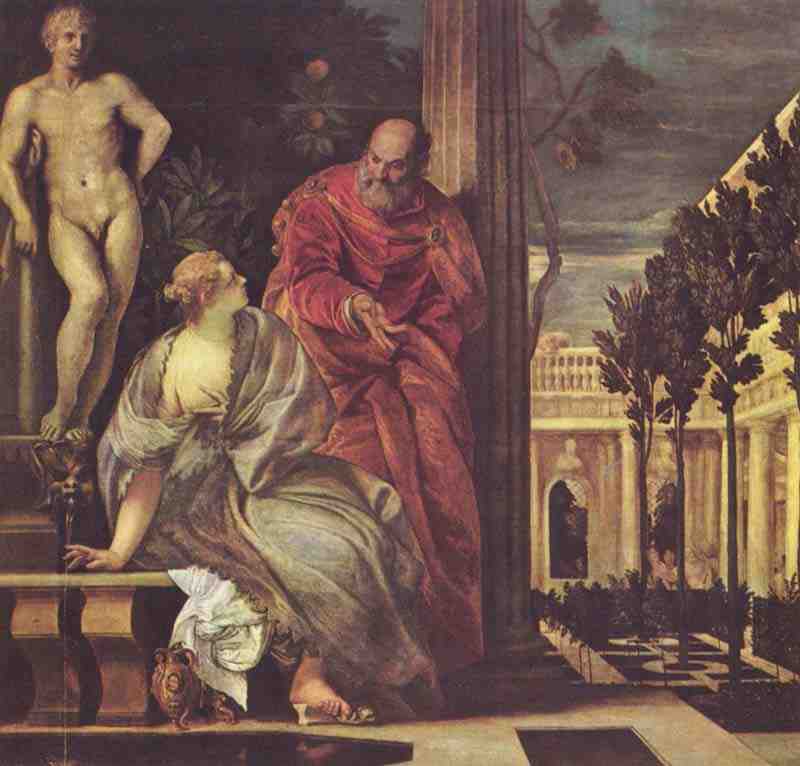
Bathsheba at her Bath, Paolo Veronese
Second Third 16 Century, oil on canvas
Lyon, Musée des Beaux-Arts
--
Bathseba im Bade, Paolo Veronese
2. Drittel 16. Jh., Öl auf Leinwand
Lyon, Musée des Beaux-Arts
Stil: Manierismus
----
Η Βηθσαβεέ στο μπάνιο, Παόλο Βερονέσε
2ο τρίτο του 16ου αιώνα, λάδι σε καμβά
Λυών, Musée des Beaux-Arts
Στυλ: Μανιερισμός
----
Fine Art Prints | Greeting Cards | Phone Cases | Lifestyle | Face Masks | Men's , Women' Apparel | Home Decor | jigsaw puzzles | Notebooks | Tapestries | ...
----
See also : Bathsheba, Paintings, Drawings
See also : Bible, Paintings, Drawings
Bathsheba at her Bath is a painting by Italian Renaissance painter Paolo Veronese, dated around 1575 and now in the Musée des Beaux-Arts de Lyon, France.
History
This work is a marriage painting by Veronese ordered by a Venetian customer dealing with the theme of adultery linked to that of Justice and shows eroticism between the main two characters.[1] The painting arrived in France in the seventeenth century in the royal collections. It was then kept at the Palace of Versailles, enlarged atop and on the left side to match the woodwork. It was sent to Lyon by the State in 1811, and is currently exhibited at the Musée des Beaux-Arts de Lyon. Its original format was restored in 1991, keeping the extension behind the new guidelines.[2]
Composition
The painting depicts a biblical scene: Bathsheba when she is seen by King David from the terrace of his palace while she bathes in the evening. But uncertainty about the subject represented. However, although it is generally agreed that the subject of the painting is Bathsheba at her bath, the scene could represent another biblical story, namely Susannah and the Elders, in which a very beautiful woman, who bathes on a hot day and is watched by two old men (who are the characters in the arcades in the background) who unsuccessfully tried to have a sexual intercourse with her and eventually unjustly accused her of adultery.
In this painting, one of his many masterpieces, Veronese vertically divided the space into two separate parts, yet linked by agreements in the colors and a powerful chiaroscuro. The old man wears the cloak of gold buttons which is characteristic of the Doges of Venice. The arms represented on the pitcher may reflect the celebration of a marriage or an alliance between two powerful Venetian families.[2]
Analysis
According to art historians Daniel Arasse and Joséphine Le Foll,[3] two themes are intertwined in this painting:[4]
The theme of Susanna is suggested by the presence of the fountain and an old man, but there is only one (if one considers that the elders are the ones in the arcades, while the presence of man in red in the foreground is inexplicable).
The theme of David and Bathsheba has an old David, and this is unusual especially as artists generally follow the Bible, in which David sent a young messenger to Bathsheba rather than going to meet her in person, as in the painting by Jan Matsys in the Louvre. However in other paintings of this subject it is sometimes David himself who comes to see Bathsheba, which would be the case here.
References
^ "Véronèse, Bethsabée au bain" (in French). Arts-ens-lsh. Retrieved 18 March 2010.
^ to: a b "Véronèse (Paolo Caliari, dit), Bethsabée au bain" (in French). Musée des Beaux Arts de Lyon. Retrieved 18 March 2010.
^ Joséphine Le Foll. "La Bethsabée au bain de Véronèse : tableau de mariage, allégorie morale, procès en justice ? L'iconographie à l’épreuve de la peinture vénitienne" (in French). Centre de recherches sur les arts et le langage. Retrieved 18 March 2010.
^ "Bethsabée au bain" (in French). Cine club de Caen. Archived from the original on 28 March 2010. Retrieved 18 March 2010.
Retrieved from "http://en.wikipedia.org/"
All text is available under the terms of the GNU Free Documentation License


